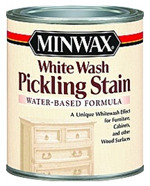
I’m building some coffee tables and I’m using quartersawn white oak and I was wondering if you could recommend a finishing product(s) that achieves the following:
• Grain is visible
• Grain has texture to the touch
• Either solid white or opaque white finish
• Extreme durability
• Cleanable/washable
VOCs aren’t a major concern at this point. Neither is the sheen. I suppose I would also need a sealer. Any help would be great! Thank you! – Chris Kerr
 Chris Marshall: I’d go with a two-part finishing process for your coffee tables. First, color the wood with a semitransparent, oil- or water-based “pickling” stain. They come in white and off-white colors. Or, you can thin ordinary white paint with the appropriate solvent for the paint (water for latex, or paint thinner for oil-based) to create a dilute, thinner paint solution. Brush the stain or paint onto the wood and wipe off the excess so you can still see the white color but also some of the grain showing through. Pickling this way will also allow the wood’s texture to remain, because stain or thinned paint don’t build to a coating that covers and fills in the wood’s pores and grain texture. When that dries, I’d topcoat with a water-based polyurethane varnish. That will give you the extreme durability you’re after without giving the wood the amber tint of oil-based varnish. And, poly is about as tough of a consumer coating as it gets, so moderate cleaning and washability won’t be a problem when needed.
Chris Marshall: I’d go with a two-part finishing process for your coffee tables. First, color the wood with a semitransparent, oil- or water-based “pickling” stain. They come in white and off-white colors. Or, you can thin ordinary white paint with the appropriate solvent for the paint (water for latex, or paint thinner for oil-based) to create a dilute, thinner paint solution. Brush the stain or paint onto the wood and wipe off the excess so you can still see the white color but also some of the grain showing through. Pickling this way will also allow the wood’s texture to remain, because stain or thinned paint don’t build to a coating that covers and fills in the wood’s pores and grain texture. When that dries, I’d topcoat with a water-based polyurethane varnish. That will give you the extreme durability you’re after without giving the wood the amber tint of oil-based varnish. And, poly is about as tough of a consumer coating as it gets, so moderate cleaning and washability won’t be a problem when needed.
Tim Inman: Back in the late 1950s and early 1960s, the finish you describe was common, popular and frequently known as “limed oak.” Although a complicated finish in some ways, the essence is this: After the wood is sanded smooth and sealed with a thinned wash of something like shellac, then sanded smooth again, an opaque white or white-ish thin paint is applied. This is wiped off with soft rags, or feathered off with a big soft brush. Sometimes this is referred to as “negative” painting in that you are trying to selectively remove the paint, not put it on. When you have “the look,” then the paint is allowed to dry. It is then topcoated with clears to produce the final finish. Of course, finishers can never leave well enough alone, so there are multiple color tricks that can be included in this finish to 1. make it more dramatic and 2. make it virtually impossible to copy or repair. The color comes from the paint layer, the durability comes from the topcoats.





